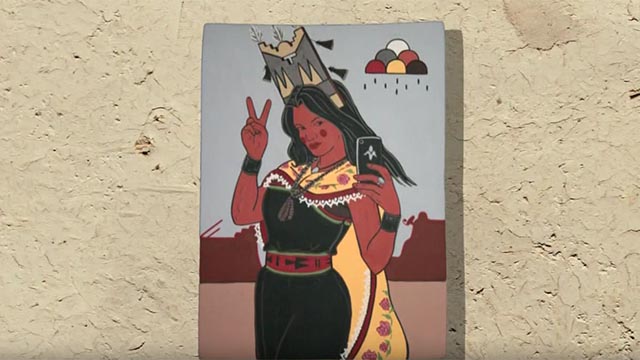Garcia, Jason

Jason Garcia (Okuu Pin) does what great artists have been doing since the beginning of time: he carefully examines and interprets life around him and then shares those uniquely personal observations with the rest of the world. In his finished work—most often clay tiles that are created in the traditional Pueblo way with hand-gathered clay, native clay slips and outdoor firings — he transforms materials closely connected to the earth into a visually rich mix of Pueblo history and culture, comic book super heroes, video game characters, religious icons and all things pop culture.
The son of well-known Santa Clara Pueblo potters John and Gloria Garcia (known as Golden Rod), and the great grandson of the equally revered Santa Clara potter Severa Tafoya, Garcia notes he has been an artist all his life. He says, “I really don’t know much else…” However, in 2002, when he created his first “graphic tile,” he secured this calling while simultaneously expanding the norms of contemporary Pueblo pottery. His creative experimentation seamlessly blended ancient Pueblo designs, stories and scenery with images taken from Western popular culture. In his seminal piece “Grand Theft Auto – Santa Clara Pueblo,” for instance, Garcia replaced the illustrations from the cover of the video game Grand Theft Auto with scenes from Pueblo life, deftly joining worlds that may, to outsiders, seem unrelated.
Since that time, he has participated in several significant exhibitions including Comic Art Indigene at both the Museum of Indian Arts and Culture in Santa Fe, New Mexico and the Smithsonian National Museum of the American Indian in Washington, DC and Native Pop! at the New Mexico Museum of Art in Santa Fe, New Mexico. Garcia has also received numerous awards and honors including a Ronald N. and Susan Dubin Fellowship at the School for Advanced Research, and both the coveted Best of Classification and Artist’s Choice awards at the world-famous Santa Fe Indian Market. Important museums have purchased his work for their collections, as well, including the Heard Museum in Phoenix, Arizona, and the Smithsonian National Museum of the American Indian in Washington, DC.
With a number of artistic accolades already under his belt, Garcia shows no signs of slowing down. His work continues to evolve with opportunities to experiment in other mediums (like printmaking via the Map(ping) Project at Arizona State University) and with series such as “Tewa Tales of Suspense,” where Garcia documents important Pueblo events in a narrative, comic book style on clay tiles (a nod to both his fondness for “Love and Rockets” by Los Bros. Hernandez, as well as Santa Clara Pueblo artists such as Pablita Velarde and Lois Gutierrez de la Cruz).
While it’s hard to predict exactly what direction Garcia’s art will go in next, since, as Garcia says, he is inspired by everything around him, one can be sure that his love for storytelling, appreciation for the methods of his craft and ability to blend the ancient with the present will continue to both inspire and inform.
Episodes:
Adam McKinney, Midori, Jason Garcia
Jason Garcia, The Missing Peace Art Space, Dance – the Next Generation (2016)
Jason Garcia, The Missing Peace Art Space, Dance – The Next Generation (2015)
Website
